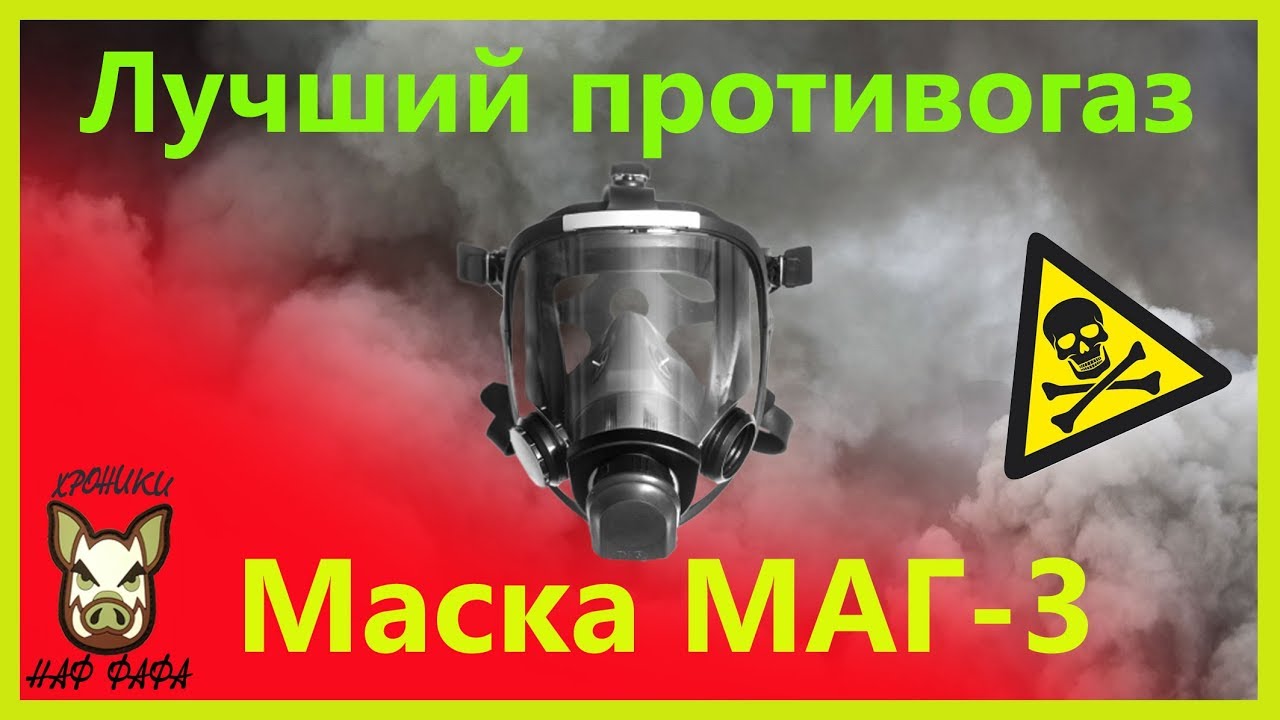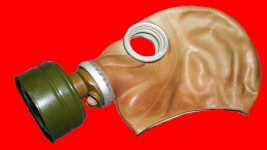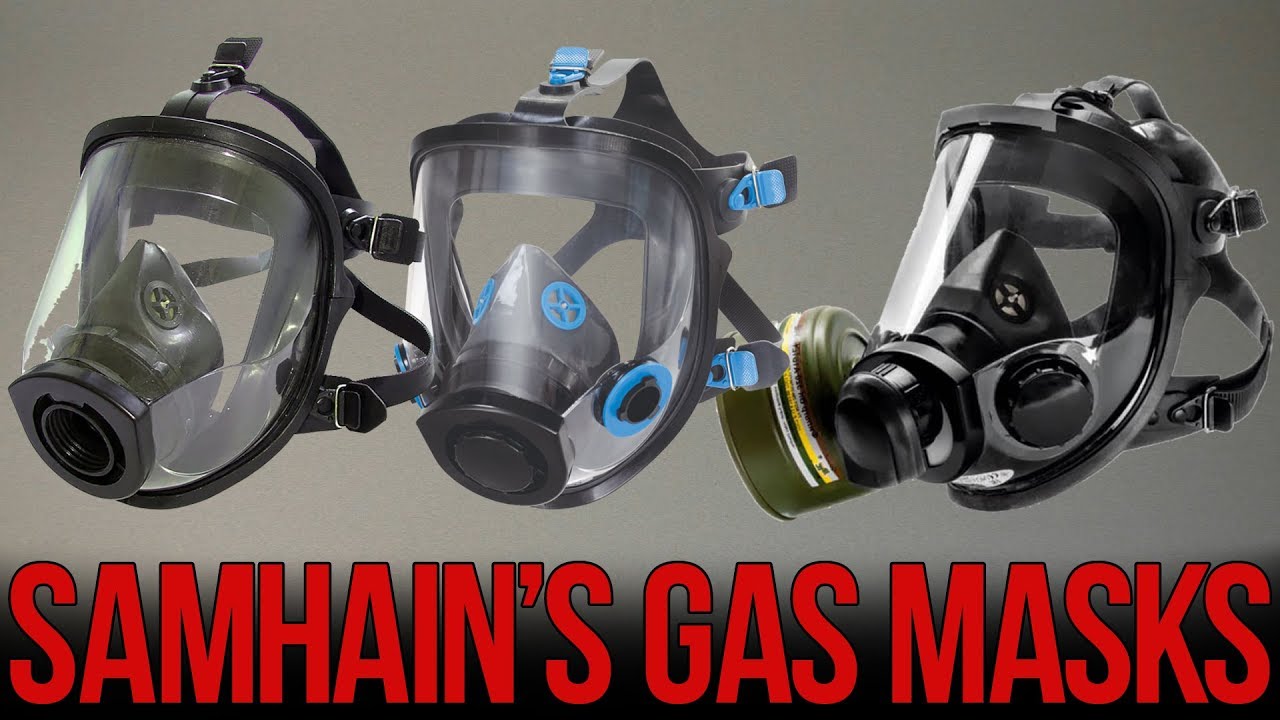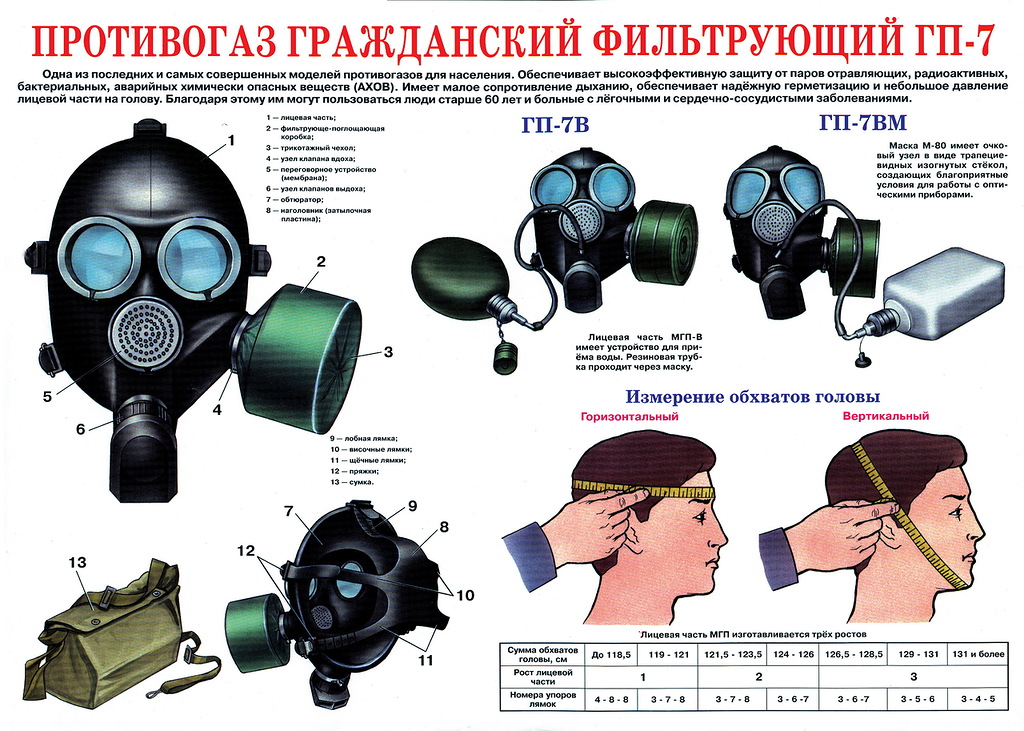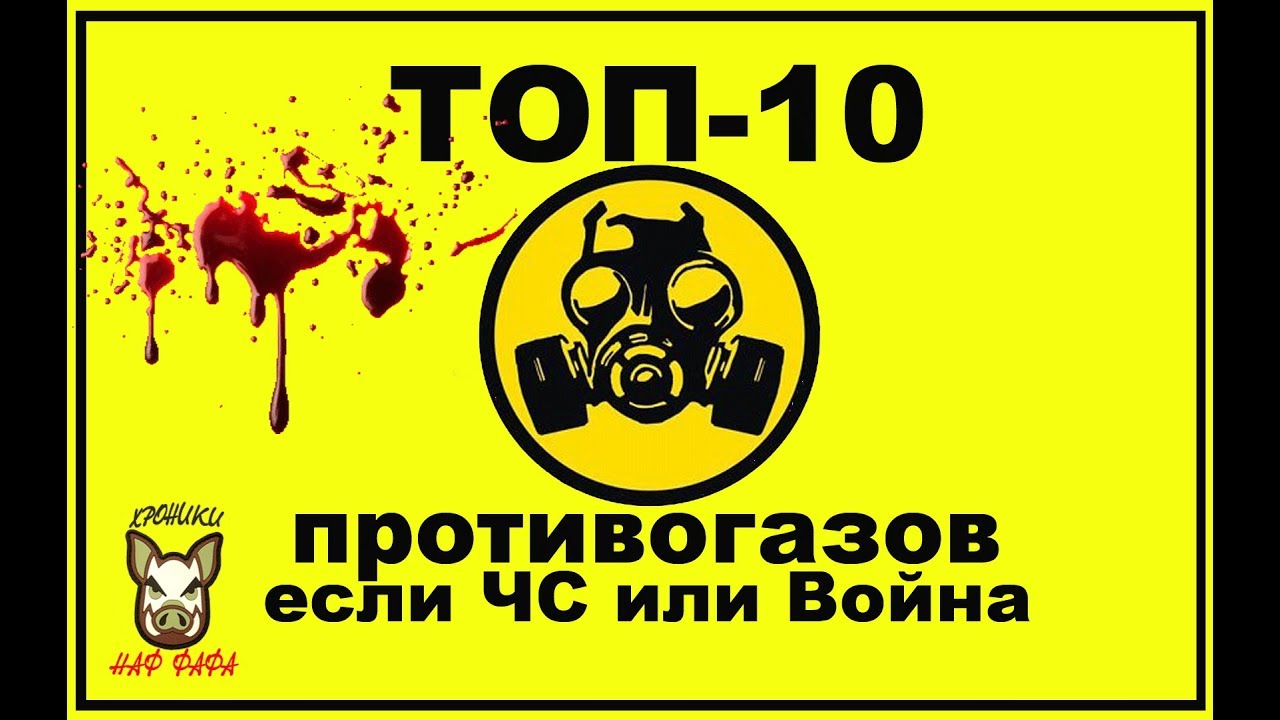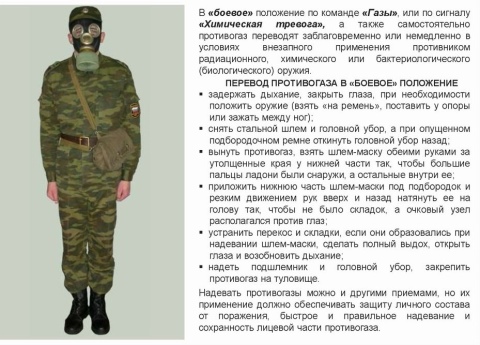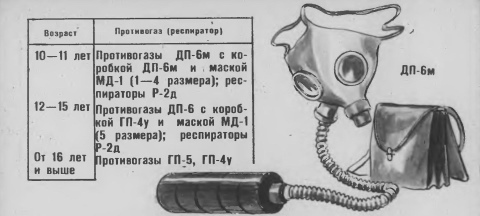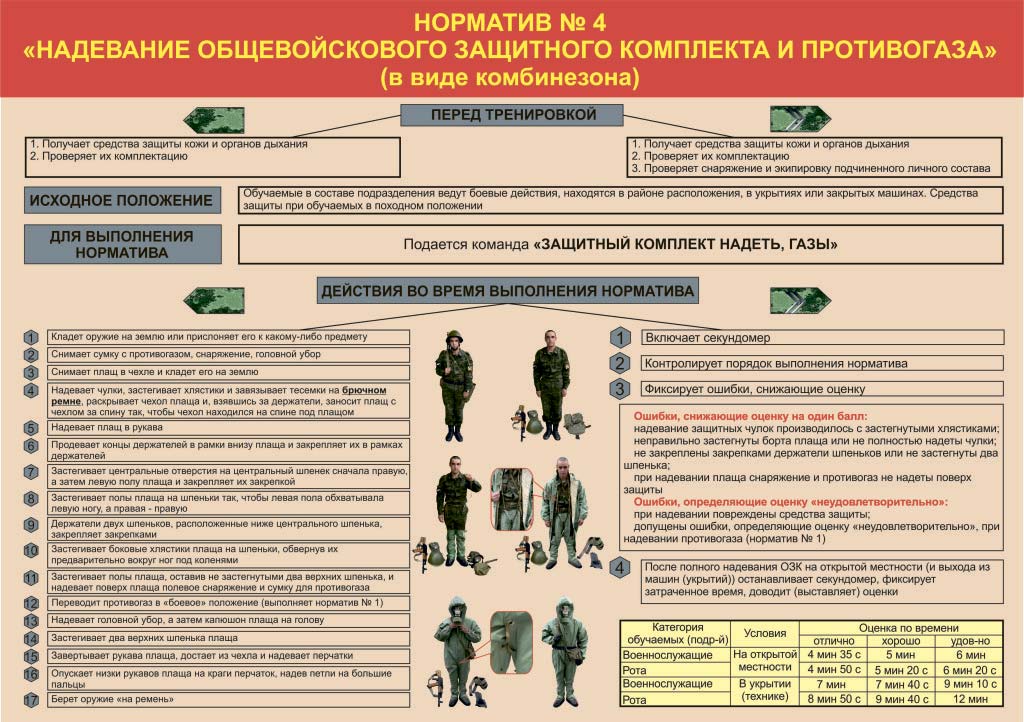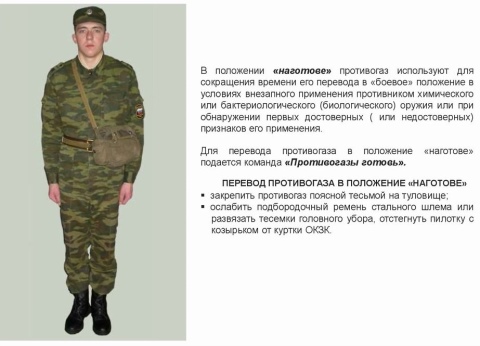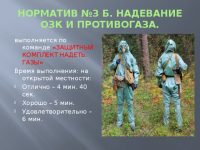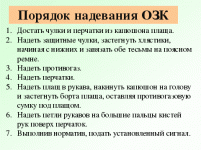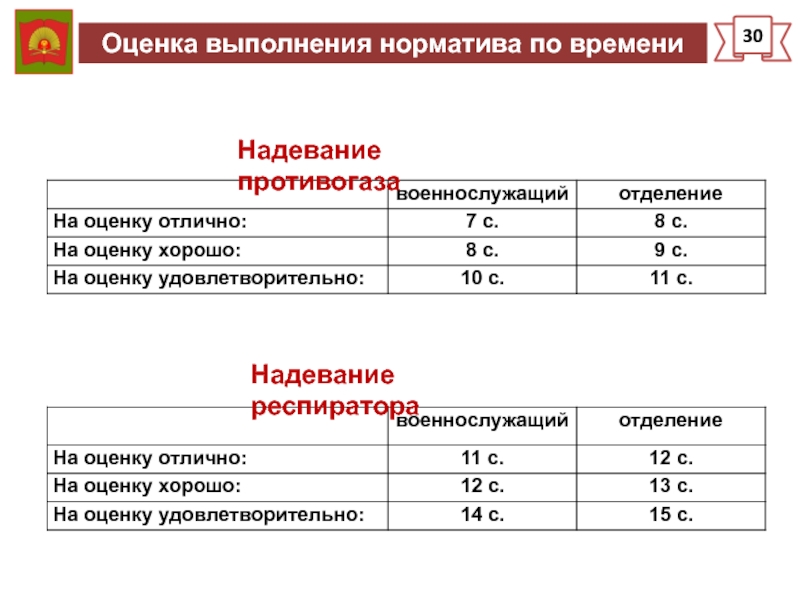What position can a gas mask be in?
The use of a gas mask is provided in dangerous situations when there is a need to protect the respiratory tract of a person. To use the product efficiently and effectively, you need to know the basics of its operation. The rules of use can be useful not only during exercises, but also in an emergency.
The order of actions in an emergency or dangerous situation can be extremely important, therefore it is worth paying attention to this.
"Camping"
In the "marching" version, the product should hang on the side of the left hand, which will allow you to move freely, without restriction of movement. To switch to the "stowed" position, a bag with a helmet-mask is put on over the right shoulder. This allows you to install the gas mask to the left, with the valve away from you, in order to have the fastest and most convenient access to it.
It is also important to set the height of the bag with a helmet-mask so that it is convenient to use it, while the optimal position will be the level of the belt
Once the bag is in the right place, you need to take out the gas mask and check it for strength and integrity.
It is important to monitor the cleanliness of the glasses and the condition of the anti-fog films, as well as the exhalation valves. If the product is completely ready, it is placed in a bag and securely fastened
"Ready"
When switching from the "marching" to the "ready" position, the command "Air raid alert!" or "Get the gas mask ready!", after which the bag is moved forward, which will allow you to more quickly reach the filter product. It opens a valve for quicker access to the helmet-mask.
If a helmet is worn, the straps are loosened on it. In the presence of additional things, the gas mask is worn under the strap of the duffel bag, and for the military it is placed over the harness of the equipment.
"Combat"
In the "combat" state, protective equipment is transferred by the signal "Radiation hazard", "Chemical alarm" or "Gases". In addition, a person can use a protective agent himself, if there are reasons for this. When transferring from one position to another, the eyes close their eyes tightly, and the breath is held, after which the head is freed from any headdress. After the preparatory steps, you need to remove the gas mask from the bag, then the product is taken with both hands by the lower part and placed on the chin, after which it is pulled over the head.
As soon as the gas mask is put on, you need to exhale and open your eyes, and then establish calm breathing. When the process is under control, you can put on a helmet or what was previously on your head and close the bag.
Size selection
Most often, the GP-7 gas mask is used to protect the face and respiratory organs. To determine its size, you need to measure the head circumference horizontally and vertically. According to the first option, a centimeter tape runs along the forehead. Vertical girth assumes measurement along the crown, cheekbones, chin.
The results must be added, after which the size must be determined using the following data:
- Size 0 - up to 93 cm;
- 1 – 93-95;
- 2 – 95-99;
- 3 – 99-103;
- 4 - more than 103.
You need to use only a suitable gas mask, since it will reliably protect against harmful substances. An inadequate device is uncomfortable, and besides, it will not be able to completely shield from polluted air.
Withdrawal
Removing an infected cloak, which is worn by a cape, must be according to strictly defined rules. Turn your face in the direction from which the wind is blowing, place or lay down your weapon. If a raincoat with a cover - untie the holders, slightly holding them, pull them out of the frames.Using the holders, lift the cloak and discard it so that the infected side hits the ground. If there was no cover, you need to throw off the hood from the head, untie the holders from the belt, lift the raincoat and throw it back.
When moving in open transport, servicemen remove the OZK after stopping and disembarking. A raincoat contaminated with toxic chemicals or bacterial aerosols, put on the sleeves, is removed only if there is no possibility of its disinfection and degassing. The overalls are also removed after the command “Remove the protective kit”.
When removing the OZK, it is necessary to carefully monitor that open areas of the body do not touch the infected outside. If necessary, degassing is carried out using the IDP-1 formulation. First of all, a weapon, a protective helmet, a gas mask, a case for glasses. When the kit is removed, you need to immediately move away from the infected person to the windward side, treat the equipment, uniforms, shoes and a bag for a gas mask with a DPS-1 package, and then remove gloves and a gas mask.
Features of storage and use
To save the device, you must follow the rules for its use. This will extend the period of use. And the instructions for operating the gas mask will help with this:
- avoid mechanical damage;
- handle valves carefully;
- the negotiating membrane must be integral;
- do not touch the external parts of the device if you have recently been in an infected area;
- the device must be protected from moisture;
- the gas mask must be stored assembled at a distance of at least 3 meters from the heating equipment.
In order to preserve the protective agent for a long period, checks are periodically performed. First, this is done 6 months before the end of the shelf life, and then 5 years after the warranty. Further checks are carried out every 2 years. The rules for testing protective equipment were approved by the Ministry of Emergency Situations of the Russian Federation. Every week, you need to check the stacks, the quality, the integrity of the packaging, the stacking. If defects were found, then the necessary elements must be replaced.
The manufacturer guarantees the safety of the device for about 12 years from the time of manufacture. The device can be stored for a maximum of 25 years. After that, the gas mask must be replaced. If any parts have been damaged, then they must be replaced in a timely manner. This will prevent human infection. Many devices are now on sale that protect people from a contaminated environment.
Rules for choosing the right size
At first glance, it seems that any gas mask can suit a person. In fact, these devices, like hats, have sizes.
If the model is large, it will not be able to provide absolute tightness. On the other hand, a small gas mask will not be able to quickly put on and take off, and the person will not be entirely comfortable inside.
To choose the right gas mask, you need to know two parameters: vertical and horizontal head circumference. The first indicator is measured along the length of the vertical line passing through the chin, cheeks and crown. The horizontal girth is a closed line running along the brow ridges, 2-3 cm above the auricle and through the most protruding back of the head (Figure 3).
Figure 3. All products are selected strictly according to size
All obtained measurements must be rounded up or down so that the last digit is 0 or 5. Now you need to add both digits together and see the result. An indicator less than 1190 cm corresponds to the first size, 1190-1210 - the second, 1215-1235 - the third, 1240-1260 - the fourth, 1265-1285 - the fifth and from 1290 to 1310 - the sixth.
What is the duration of the work without interruption?
At any enterprise, protective equipment in the form of gas masks is provided, therefore exercises are regularly held so that everyone knows how to use them correctly. Gas masks are stored in a designated place and are under a seal that cannot be torn off.The quantity of this protective equipment should be appropriate for the personnel of the enterprise. In the event of an emergency with the use of gas masks, their number is checked and replenished after the end of the incident.
You must be able to properly store protective equipment and be checked on time. In addition to the main kit, there should also be a backup one.
The time spent by the worker in the hose gas mask is 30 minutes, after which a rest or respite is required. If you increase the duration of being in a helmet-mask, its useful life will expire, and the person may become ill. After the end of use, the equipment is put in order, dried and cleaned, then stacked according to the storage rules.
Other techniques for putting on a gas mask
And by other methods, you can put on gas masks, but their use should ensure correct and quick donning, as well as the safety of the face of the gas mask.
In order to put on a gas mask in the prone position, you need to: close your eyes, hold your breath, put your weapon on and take off the hat with a steel helmet, get the gas mask out of your bag and put it on, inhale, open your eyes, and continue breathing.
In order to put on a gas mask on the wounded, you need to put the wounded person on or put, taking into account the situation and his condition, take his gas mask out of the bag and put it on the head of the wounded.
When wearing a helmet (tank helmet), the gas mask is transferred to the "combat" position by the methods indicated above, but the following additions are made: before putting on the gas mask, the laryngophones and the helmet should be unfastened, after putting on the gas mask, put on a special comforter and the tank helmet back on top of it, fasten the laryngophones. Untie the adjusting straps on the headset before putting it on the face of the mask.
To put on the gas mask, the drivers of tracked vehicles slow down, and the drivers of wheeled vehicles make a short stop. In the process of preparing for the use of PMK and PMK-2 gas masks, it is necessary to remount the caps on the army flask: unscrew the ordinary flask lid, remove it from the chain and put it in the bag, Release the lid with the valve from the packaging, attach to the chain and screw it all the way onto the neck of the flask ...
If you do not have a flask, then it is worth keeping the flask lid with the valve in your bag, without removing the original packaging.
In the process of preparing for the forcing of various water obstacles by swimming in the absence of BA, RP, 0V in the air, it is necessary to protect the FSP from water entering them. It is necessary for this to use waterproof bags that are included in the set of gas masks PBF, PMK and PMK-2.
Place the assembled gas mask in the inner bag, twist its edge tightly, bend it and secure it with a rubber ring, making the maximum possible number of loops with it. Also seal the outer bag.
Expert opinion
Dmitry Tarasov
Master of Sports in Mountaineering. Author of scientific articles on wildlife survival
Place the bag with the gas mask in the bag to the valve of the bag with a sealed end. Remove the gas mask after crossing the water barrier, dry the bag, put the gas mask in the bag in the bag.
In order to protect FPK gas masks RSh-4, PMG and PMG-2 from water, it is necessary to disconnect the boxes from the front parts and plug them with rubber caps and plugs, having previously checked the presence of a rubber gasket in them. After the water barrier is overcome, it is necessary to wipe all the components of the gas mask, dry the bag, replace the anti-fog films, assemble the gas mask itself and put it in the bag.
Gas masks of the PMK and PMK-2 brands are equipped with a system for receiving liquids even in a contaminated atmosphere. In order to use this system, it is necessary to equip the flask with a lid with a valve, plug it with a rubber stopper. Fill a flask with liquid in a non-contaminated atmosphere.
Terms of use
In order for the device to work for a long period, the correct application of the gas mask is necessary. To stay in the device for a long time, you need to breathe evenly and deeply. It turns out after constant training. Thanks to this, the combat capability of a person who will be able to act correctly in the affected area is preserved.
If there is difficulty in breathing, then you need to knock on the box a little, which will eliminate dust or snow. When the situation continues, you need to remove the cover, and after removing everything unnecessary, put it back on the box. If you do not need to use a gas mask, then dust must be removed before putting it in your bag. The condition of the device should be checked regularly to ensure that there are no foreign particles on it.
Preparation
The vast majority of the civilian population does not know how to use a gas mask correctly, and in life most people have never come across this personal protective device. Putting on a protective device quickly and correctly is taught at school, where a course of lectures on civil defense is read for schoolchildren, and this manipulation is also mastered in the army and units of the Ministry of Internal Affairs, the Ministry of Emergency Situations. The specialists of these services pass the standard, the time of which is strictly regulated.
The use of a gas mask is justified in those cases when a "Gases" warning was given or a message was received about radioactive or chemical pollution of the environment that arose as a result of a man-made disaster or in other extreme situations.
The horizontal parameter is measured at the level passing in the area of the eyebrow line, then 3 cm above the level of the upper point of the ear and passes along the most protruding part of the back of the head. The vertical parameter is measured at the level that passes through the parietal region, further along the cheek and to the chin. The results obtained should be rounded to produce an integer ending in "0" or "5".
After measurements are taken, they must be flattened, and the sum of the two numbers will determine the size of the personal protective device. The size scale looks like this:
- 1260-1310 mm - VI size;
- 1265-1285 mm - V size;
- 1240-1260 mm - IV size;
- 1215 - 1235 mm - III size;
- 1190-1210 mm - II size;
- 1190 mm and less - I size.
The gas mask has the ability to protect not only the respiratory system, but also the eyes, as well as the face and head from the aggressive effects of hazardous substances. The design of the protective device is based on the filtration principle, but not all models will be able to protect a person from ammonia and other chemicals, the boiling point of which exceeds 65 ° C, and not every gas mask saves from carbon and nitrogen oxides. For certain types of hazardous substances, special models of gas masks have been developed. For some of them, filtration occurs through a special cartridge PZU-PU.
How to quickly put on the whole set
Put the raincoat in a cover on the ground, put on stockings, fastening with straps and fastening the braid on the belt (on the belt), open the cover of the raincoat, grab the holders and put on the raincoat so that the cover is under the raincoat on the back. Put on the sleeves, thread the ends of the holders into the frames at the bottom of the raincoat and strengthen them there, fasten the holes with a pin in the center, first the right floor, then the left one, securing them, fasten the pins on the floors of the raincoat so that each of them covers the leg - the left floor is the left one, and the right sex is the right one. After that, it is necessary to fix the holders of the pegs below the central one, fasten the side straps, wrapping them under the knees.
Now only the upper pins are unbuttoned. Field equipment and a bag for a gas mask are put on over the cloak, the gas mask itself is transferred to a combat position. It was the turn to put on the comforter, fasten it and tuck it under the jacket, then put on the hat and helmet, on it - the hood of the raincoat. Now fasten the upper pegs, wrap the sleeves.Take out the gloves, put them on so that the lows of the sleeves of the cloak are lowered on the leggings of the gloves, and the loops are on the thumbs. Take a weapon. In areas contaminated with toxic chemicals, the order of putting on the OZK in the form of overalls is the same, only the gas mask is in the “Gases” position, and you cannot take it off while putting on the kit.
How to put on the OZK: the order and standard of putting on. Combined arms protective kit: dimensions, purpose
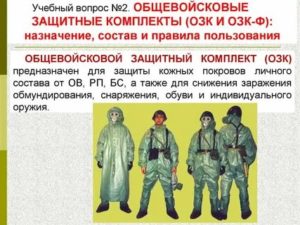
A combined-arms protective kit that protects the skin of a person from biological and toxic substances, from radiation damage, also reduces the contamination of uniforms, shoes, equipment and individual weapons. How to put on the OZK according to the standard, and will be described in this article.
Appointment
OZK is manufactured in combination with filtering personal protective equipment.
If it is put on in advance, then it will be able to save the fighter from the consequences of a nuclear explosion (light radiation), from open flames and fire mixtures, almost all thermal factors will not affect him so destructively, moreover, the equipment under the kit will also not suffer significantly. It is not intended for constant wearing, it is used periodically, but every soldier should know how to put on the OZK quickly, and do it on time.
If contamination with toxic substances is expected, biological or radiation damage is threatened, then the combined-arms protective kits undergo special processing for repeated use. A protective kit is assembled directly in the units, where the fighters learn to resist chemical and biological contamination (first of all, how to put on the OZK).
In divisions and warehouses, protective raincoats with covers (OP-1M), gloves, OZK stockings, covers for gloves and stockings are ordered and delivered separately. Completely such a kit should consist of seventeen components.
The OZK device in the kit is packed in covers, and the fasteners and pins are packed in gauze bags. Judging by the configuration, servicemen need special knowledge on how to put on the OZK.
First, the kit must be sealed. To provide him with this quality, the bottom of the sleeves is pulled together with elastic bands, and the size of the hood must be adjusted with a tightener. The sleeves themselves are fixed with loops that are put on the fingers.
The OZK cloak fastens with pegs.
What is also worth paying attention to when putting on a gas mask
Hats, glasses, mustaches, thick bangs can lead to leakage of some models of gas masks. Therefore, before putting on a gas mask, try to minimize this kind of facts as much as possible, remove hair from the forehead and temples, comb long hair back, remove hairpins and other jewelry from the female sex.
The rules for using a gas mask are described in the article "Using a gas mask".
When using a gas mask at subzero temperatures, it is worth considering the fact that rubber can harden in cold weather, and as a result, the size of the gas mask will decrease, which will create certain difficulties when putting it on. Therefore, when using a gas mask in winter, it is recommended to wear it under outerwear, and when wearing the apparatus, periodically heat the breathing valves with your hands.
Technique for fulfilling the standard¶
- a firefighter's belt with an ax in a holster, a carbine to which gloves are fastened, folds in two or three times, the belt buckle is turned up;
- the trousers are first folded along the longitudinal seams of the legs, then twice (three times) across so that the front section of the trousers with the edges bent outward is at the top; the trousers are put on the jacket, with the belt towards you, and the straps are tucked into the folds of the trousers;
- the jacket is folded along the longitudinal seams inside out, with the sleeves inward and twice along the waist, with the back up, with the hemlines bent under it and fits on the belt with the collar facing you;
- a helmet (helmet) with a removed face shield is placed on trousers, with a cape towards itself;
- rubber (leather) boots are placed under the rack (shelf) with the toes away from you.
a
a
a
a
a
a
2. Stacking combat clothing and equipment
- Combat clothing and equipment are put on at the signal: "Anxiety!" or by command: "Combat clothing and equipment - put on!".
- At this command, a firefighter, facing folded combat clothing and equipment, pushes his helmet (helmet) to the side (Fig.3a).
- Then he takes the trousers by the cuffs with both hands. (Fig.3b), transfers the center of gravity to the right leg, while bending the left at the knee.
- Pulling the toe of his left leg down, the firefighter pushes it into the left leg of his trousers (Fig.3c).
- Puts on the left leg, while straightening the leg and pulling the leg with his hands towards himself; stands on the left leg, transfers the center of gravity to it and puts on the right leg in the same way as the left. Then he grabs the straps of his trousers with his hands and puts them on his shoulders. (Fig.3d).
- The bottoms of the trousers are tucked, casual shoes are removed and safety shoes are put on; the trousers are straightened over the safety shoes.
- Next, the firefighter puts his hands in the sleeves of his jacket. (Fig. 3d, f), and moving the arms up (arms straight) the jacket is thrown over the head and thrown over the shoulders (Fig.3g)... Spreading to the sides and lowering his arms down, the firefighter completely pushes them into the sleeves.
- Then all the carabiners of the jacket are fastened.
- Put on a fire belt and fasten with a buckle, the free end is fixed with a collar (Fig. 3h).
- A helmet (helmet) is put on, the chin strap is tightened and fixed.
(Fig. 3i)
a
a
b
b
v
v
G
G
d
d
e
e
f
f
s
s
and
and
To
To
3. Putting on firefighter combat clothing and equipment individually
Sources of
- Standards for fire-fighting and tactical-special training for the personnel of the Federal Border Guard Service of May 10, 2011
- Technique for complying with mandatory standards for fire-fighting and tactical-special training Text: study guide / author-comp. A. A. Yusupov, M. V. Stakheev. - Yekaterinburg: Ural Institute of the State Fire Service of the Ministry of Emergency Situations of Russia, 2015 .-- 72 p.
You may also be interested in
- Standards for fire drill and special training
- Standards for GDZS
- Climbing the assault ladder to the 4th floor of the training tower
This page has no curators!

